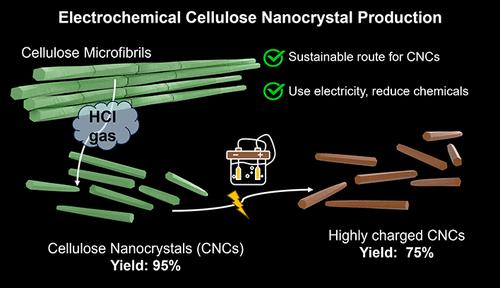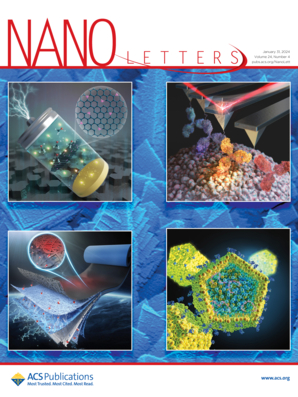通过电化学氧化实现高电荷纤维素纳米晶体
IF 9.1
1区 材料科学
Q1 CHEMISTRY, MULTIDISCIPLINARY
引用次数: 0
摘要
纤维素纳米晶体(CNCs)因其卓越的性能,已被建议用于可持续材料科学的各种应用领域。然而,最先进的生产方法产量低,且依赖于危险和对环境有害的化学品,这成为更广泛利用 CNC 的瓶颈。在本研究中,我们提出了一种新颖的两步法,将之前建立的盐酸气体水解法与电化学 TEMPO 氧化法相结合。这种独特的方法可以收集到易于分散且羧酸盐含量高的氯化萘,总产率高达 71%。电催化氧化是在水性条件下进行的,通常不需要助催化剂,从而简化了材料的纯化过程。此外,所提出的工艺设计便于回收两个步骤中使用过的试剂。为了评估可持续性和可扩展性,计算了环境影响因子,并进行了成本分析。本文章由计算机程序翻译,如有差异,请以英文原文为准。

Highly Charged Cellulose Nanocrystals via Electrochemical Oxidation
Due to their exceptional properties, cellulose nanocrystals (CNCs) have been proposed for various applications in sustainable materials science. However, state-of-the-art production methods suffer from low yields and rely on hazardous and environmentally harmful chemicals, representing a bottleneck for more widespread utilization of CNCs. In this study, we present a novel two-step approach that combines previously established HCl gas hydrolysis with electrochemical TEMPO oxidation. This unique method allows the collection of easily dispersible CNCs with high carboxylate contents in excellent overall yields of 71%. The electromediated oxidation was conducted in aqueous conditions without the usually required cocatalysts, simplifying the purification of the materials. Moreover, the proposed process is designed for facile recycling of the used reagents in both steps. To evaluate the sustainability and scalability, the environmental impact factor was calculated, and a cost analysis was conducted.
求助全文
通过发布文献求助,成功后即可免费获取论文全文。
去求助
来源期刊

Nano Letters
工程技术-材料科学:综合
CiteScore
16.80
自引率
2.80%
发文量
1182
审稿时长
1.4 months
期刊介绍:
Nano Letters serves as a dynamic platform for promptly disseminating original results in fundamental, applied, and emerging research across all facets of nanoscience and nanotechnology. A pivotal criterion for inclusion within Nano Letters is the convergence of at least two different areas or disciplines, ensuring a rich interdisciplinary scope. The journal is dedicated to fostering exploration in diverse areas, including:
- Experimental and theoretical findings on physical, chemical, and biological phenomena at the nanoscale
- Synthesis, characterization, and processing of organic, inorganic, polymer, and hybrid nanomaterials through physical, chemical, and biological methodologies
- Modeling and simulation of synthetic, assembly, and interaction processes
- Realization of integrated nanostructures and nano-engineered devices exhibiting advanced performance
- Applications of nanoscale materials in living and environmental systems
Nano Letters is committed to advancing and showcasing groundbreaking research that intersects various domains, fostering innovation and collaboration in the ever-evolving field of nanoscience and nanotechnology.
 求助内容:
求助内容: 应助结果提醒方式:
应助结果提醒方式:


